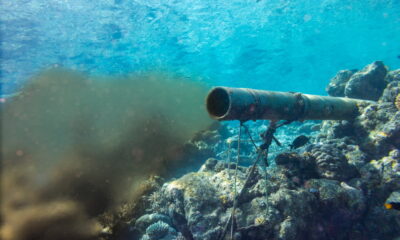

Editors Choice
7 Environmental Remediation Trends And Why They’re Important
Environmental remediation represents a promising solution to many of today’s most pressing concerns. With the perils of human encroachment, remediation services help to offset the damage, preserving natural habitats and restoring balance to sensitive ecosystems. Through these efforts, progress is possible.
In 2019, the subject of remediation has received even greater attention. Given the rapid rate of deforestation, the mass bleaching of coral reefs and other environmental crises, the necessity of restoration is inarguable. Fortunately, a diverse variety of technologies exist for the purpose of rehabilitation.
With this in mind, which technologies have shown the most potential for the process of remediation? Which trends have emerged in 2019, and what significance do they have for the environment?
This article seeks to answer those questions and others like them, examining the problems which have placed the planet at risk and the initiatives which help to save it.
Here are seven environmental remediation trends and their importance for the future.
1. Reforestation Projects in the Amazon
The Madre de Dios region of Peru is the “biodiversity capital” of the country, a gateway to a large area of protected lands. It’s also full of natural gold deposits, which has created a significant problem. Between 1996 and 2016, gold mining resulted in the removal of 262 square miles of rainforest in the region.
Recently, the Amazon Center for Scientific Innovation implemented its mining restoration plan, the first application of an extensively researched technique. Their attempts at reforestation will take a considerable amount of time, but if they achieve success, their project will set a precedent for future efforts.
2. Manipulation of Plant Microbiomes
The demand for sustainability in agriculture has given rise to an agricultural revolution. It involves the careful manipulation of plant microbiomes, the complex microbe communities that facilitate living cell growth, drought tolerance, food expansion and disease resistance, among many other agricultural benefits.
As context, a foundational study at the Max Planck Institute for Plant Breeding Research led to greater interest and investment, giving rise to new technologies which enable scientists to control microbiomes. These innovations will allow for the restoration of affected ecosystems, in addition to the production of highly nutritional foods for disadvantaged populations.
3. Collaboration in Algae Remediation
The algae bloom situation affecting fishing, tourism, real estate and local economies may soon see a solution. In an attempt to manage and contain the escalating issue, the National Algae Association has invited commercially-minded researchers and remediation technology and equipment companies to collaborate.
In May of this year, they plan to discuss the different types of algae blooms and educate attendees about emerging technologies. So far, the response to these collaborative efforts for remediation is overwhelmingly positive. It’s a strong indicator that future projects of the same nature will enjoy similar success.
4. Shinorine for Eco-Friendly Sunscreen
The active ingredients in a range of sunscreen products contribute to coral bleaching. In acknowledgment of this issue, certain groups have proposed the replacement of harmful substances with the compound shinorine. It’s a biodegradable alternative which has promise, but it’s not without its issues.
Among other effects which are, as of yet, unknown, shinorine can cause inflammation in humans. Without further research or testing, the full effects of shinorine will remain unknown, but at the present moment, it has potential. Regardless, it reflects an increasing public interest in eco-friendly products, an emerging and environment-related trend which is beginning to gain momentum.
5. Dredging for Remediation and Maintenance
Dredging has a diverse range of applications, assisting with environmental remediation in multiple ways. The dredging process can remove contaminants from chemical spills, sewage accumulation and stormwater runoff, as well as other harmful materials. It’s an effective means of maintaining waterways.
As another example of the benefits of dredging, the equipment can remediate eutrophication, an excess of nutrients in the water due to runoff. With the machinery’s capacity for environmental remediation, it will continue to prove its value in present and future projects moving into the next decade.
6. Voluntary Wetland Restoration Efforts
The EPA estimates an annual loss of 100,000 acres of wetland in the United States alone. Even with regulations which protect these areas, the amount of wetlands continues to decline. However, organizations committed to their preservation have established voluntary programs to assist interested landowners.
While these programs aren’t necessarily new, they call attention to an important truth at the heart of environmental preservation. Remediation isn’t the sole responsibility of government organizations and companies. Well-intentioned individuals who want to participate can make a difference on their own, with or without the assistance of other people.
7. The #TrashTag Challenge Movement
On the subject of individual contributions, the #TrashTag challenge has gained traction on social media sites. It prompts people from around the world to visit an area affected by pollution and litter — such as beaches, roadsides, parks, etcetera — and collect trash and debris until the space is clear of any refuse.
Participants show the changes they’ve made to an area with “before” and “after” pictures, posted on Facebook, Twitter and other platforms. It’s a simple way to publicly share their contribution. Given the popularity of the #TrashTag challenge, it’s clear that social media is an effective tool for environmental conservation initiatives.
A Positive Outlook for the Future
Those interested in environmental remediation should pay close attention to the trends above. The reforestation in Peru, manipulation of plant microbiomes, adoption of dredging equipment and the #TrashTag challenge will all prove important as the country moves through 2019 into the decade to come.
With changes happening every day — for algae remediation, wetland restoration efforts and elsewhere — those who are worried over the future of the planet should feel a sense of security. Advances in technology and improvements in outdated practices have made remediation initiatives far more effective.
Even with the effects of human encroachment, companies have solutions which reduce their impact and rehabilitate the environment. The technologies and programs in this list are only a fraction of the larger picture, which isn’t one of pollution and planetary catastrophe — but hope and ecological harmony.


 Environment9 months ago
Environment9 months agoAre Polymer Banknotes: an Eco-Friendly Trend or a Groundswell?

 Environment10 months ago
Environment10 months agoEco-Friendly Home Improvements: Top 7 Upgrades for 2025

 Energy12 months ago
Energy12 months agoA Closer Look at The Rapid Growth of Solar Energy in Ireland

 Features8 months ago
Features8 months agoEco-Friendly Cryptocurrencies: Sustainable Investment Choices





























